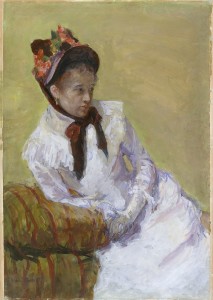Born May 22 1844 in Allegheny City, Pennsylvania; Died June 14 1926 near Paris, France
Self Portrait, 1878
Though Mary Cassatt is the first artist from America I will be covering, I don’t really feel as though she can be classified as an “American artist,” as she spent much of her time abroad. Cassatt was born into a well-to-do family in Pennsylvania, but quickly discovered her love of art. Her father, a conventional man, greatly discouraged this, and was reluctant to allow her to enroll in the Pennsylvania Academy of Fine Arts at the age of 16. Cassatt did so anyway, but found the largely male environment to be constricting and disrespectful. She set her gaze towards Europe to study art, which only served to upset her father more. He claimed he would prefer to see her “dead than living abroad as a “‘bohemian.'” In 1865, however, a young Cassatt left for Paris.
The painter spent her days traveling across Europe, studying the works of the old masters and slowly developing a style of her own. She became close to other French painters, such as Charles Joshua Chaplin, who painted many beautiful, delicate portraits of women. In 1868, Cassatt’s painting The Mandolin Player was entered into the famed Paris Salon, earning her some recognition. Soon after, the Franco-Prussian war broke out, forcing the disappointed artist to return to her family in Pennsylvania.
The Mandolin Player, Mary Cassat
This painting’s simple content is contrasted by its rich colors. The piece certainly seems to be from the earlier period of Cassatt’s career, before she embraced looser strokes and bright colors, elements of the impressionist movement.
Despite opposition from her father, Cassatt returned to Europe in 1871 at the request of the Catholic Church. She was commissioned to paint copies of old works by an archbishop, and then traveled to Spain and eventually Paris. It was there she met the renown impressionist Edward Degas in 1879, who is especially well-known for his paintings of dancers. He recognized potential in Cassatt, and invited her to join the growing impressionist movement. She was the only American in the group, but was interested in their use of color and light. Her subject matter also shifted, as she moved towards the intimate, everyday scenes of family that we associate her with today.
Ballet Rehearsal, 1873 Edgar Degas
This is a very famous example of Degas’ work– it features streaming light, dynamic movements, and bright, pastel colors. It’s easy to see why Cassatt was attracted to the movement.
Children on the Beach, 1884 Mary Cassatt
This intimate portrait is one from Cassatt’s impressionist period, and is evident in her use of light and her brushstrokes. However, her tendency to paint families, specifically mothers and children, set her apart from the movement.
Around the mid 1880s, Cassatt stopped associating herself with impressionism. She studied different techniques and mediums throughout the rest of her life, often using pastels and prints. Cassatt also started to support emerging artists from America, buying many of their works. In 1900, her eyesight began to fail, causing her to work less frequently. She passed away in 1926, completely blind due to her diabetes, in her home in Mesnil-Theribus, France.
The Fitting, 1890
This is a print from the later period of Cassatt’s career. She was actually inspired by Japanese printmaking, which seems evident in the simple style and muted, warm colors of this piece. Despite the shift in style, Cassatt still focuses on a scene from the home, for which she is so recognized.
Mary Cassatt was clearly an exceptionally talented woman, and based on her disagreements with her family, it appears that she also was independent and strong-willed. She did not feel bound to any particular movement or style, or even any specific place– she was, after all, a bit of a “bohemian.” The artist was fiercely proud of her line of work, as well; one of my sources states that she only felt like she was amongst her “intellectual equals” when she was with other artists. After constantly being discouraged from pursuing art, though, I can see why she developed such an attachment to it. I’m certainly glad she did, because her pieces are a lovely glimpse into domestic life of the time.
Next week I will be introducing a truly amazing artist, and the first sculptor in my series. Stay tuned!
URLS:
http://www.metmuseum.org/toah/hd/cast/hd_cast.htm
http://nmwa.org/explore/artist-profiles/mary-cassatt
http://www.biography.com/people/mary-cassatt-9240820#unique-artistic-expression
http://www.notablebiographies.com/Ca-Ch/Cassatt-Mary.html






Having taken 5 years of French, I certainly have had my fair share of lessons on Impressionism. We learned about Mary Cassatt, and I specifically remembering always being impressed by her motivation and perseverance throughout her life to pursue her true passion. Your analysis and input on her works were really insightful, and I enjoyed having the opportunity to read more about her life!
I really like that you include several pieces of art from each artist you blog about; it definitely helps the reader to become more engaged and learn more about the artist’s specific style by being able to visualize some pieces. I also like how you show a comparison to other artists’ pieces to show from whom she received some inspiration.
Love your blog!
This is my second time reviewing your passion blog, and each time I find the aesthetic more and more pleasing. Excellent color scheme and font choice. Now, on to the content. I found the background information very helpful and I thought there was an excellent balance of art description as well as artist information. I am not sure if this post is about the artist herself or her work, but I find that having the abundance of both extremely pleasing. Great job!